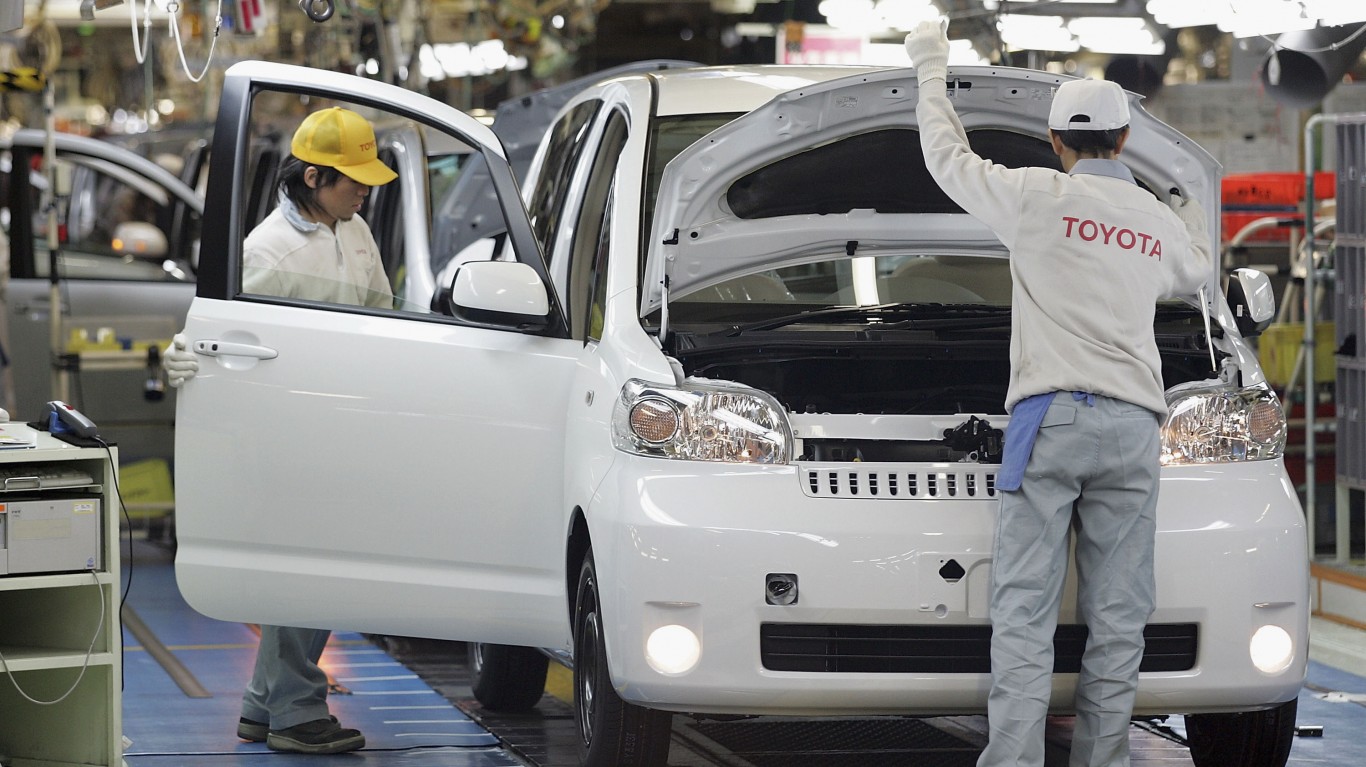
It has become inevitable that the rising number of coronavirus cases and the rising death toll are hurting many economies. There may not be widespread recession now, but some economies are more at risk than others. China was already having weakness and was supposed to start rebounding as the phase-one trade deal was signed with the United States, but the viral outbreak and reactionary shutdown of much of China’s economy are coming with a very high price. One additional economic victim may be Japan, which may be at risk of entering a technical recession.
A report from the Japan economics team at Bank of America Securities (Merrill Lynch) shows how Japan faces rising risks of recession. The report from Izumi Devalier and Takayasu Kudo expects that the fourth-quarter gross domestic product (GDP) reading for 2019 will already show deep contraction of −4.6% when it is released next week. While the October 1 tax hike is the main culprit here, the firm noted that its high-frequency data point to a steep drop in private consumption after the 2.2% rise seen in the third quarter.
On top of what had been front-loaded spending ahead of the tax hike in the prior quarter, there were also disruptions from October typhoons, followed by a negative impact from unseasonably warm temperatures in December. Weak sentiment on top of those items help to account for the severity of the consumption slump, but the team now also expects reactionary declines in both business investment and in housing investment at the same time that exports out of Japan appear to have been weak.
The outlook for the first half of 2020 already looked tough, but that now appears worse than expected, and the team was only calling for a 1% growth by the second quarter of 2020. The coronavirus impact is shown with specifics. Devalier and Kudo’s report said:
In our year ahead report, we had been looking for a feeble but positive rebound in the first quarter (2020) GDP, before an acceleration back to trend of around 1% in the second quarter (2020). But this now looks too optimistic, given the already tangible hit to regional activity and sentiment from the novel Coronavirus. Without the confidence that the outbreak has peaked, it remains difficult to quantify the impact on Japan’s economy. But the hit to tourism is already visible. According to our APAC transportation team, flight capacity out of China to Japan was tracking a 53% (YoY) drop as of 10 February. However, this likely represents the low end for the likely decline in inbound visitors in recent weeks since the Japanese government has continued to widen entry bans, including on port calls by cruise ships. Under our baseline scenario, the decline in inbound consumption (services exports) alone should shave at least 0.6 percentage point off annualized first quarter (2020) GDP growth.
While the “recession” term gets overused and has been frequently overhyped in the media, what investors and economic watchers should consider is that this is effectively considered a “technical recession.” That is when the economic data reflect a recession but without some of the widespread panic and major life disruptions that come into play with a deeper recession. Technical recessions also tend to be short-lived, along with being less destructive.
Japan’s merchandise exports and domestic production are now expected to take a small hit in the near term, with logistical disruptions being present, along with a negative hit to household sentiment tied to outbreak fears and with a capital spending recovery facing potential delays. As a result, Devalier and Kudo took the first quarter of 2020 GDP forecast down to −1.0% from a prior expected gain of 0.6%. The team currently projects a rebound in the second quarter with a 1.8% gain as business activity would be expected to normalize.
That said, the team cited high uncertainty around projections for the first half of 2020, and they see many reasons to be worried. The report added:
So far, markets have largely shrugged off the outbreak, with the Nikkei largely recovering from the losses after the Wuhan lockdown was announced. This reflects the view that disruptions from the outbreak will prove short-lived, which was the case with the 2003 SARS episode. Our base case, too, is that activity will normalize in the second quarter of 2020. … However, we have to admit that we are growing more worried. One of the reasons why we have remained sanguine about the risks of a proper recession taking hold in Japan– one involving cutbacks in jobs and incomes and not just production—is because of the combination of stretched labor markets (driven by population ageing) and structural booms in tourism and construction, among others. These structural factors have helped put a floor on domestic demand, ensuring that spillovers from direct shocks to manufacturing activity over the years (i.e. downturns in the export cycle) don’t derail the service sector expansion.
One further issue to consider about the novel coronavirus’s rising risk to the Japanese economy is that it directly affects both manufacturing and services. The services sector should be able to ultimately absorb the shock if the virus peaks soon as household confidence would bounce back and tourist flows would normalize by the summer. Moreover, the effects of the Tokyo Olympics in July could boost household sentiment and tourism, with an admission that past host cities have seen mixed effects. The team noted:
But the risk scenario is that both household sentiment and tourist flows remain weak even after the outbreak dies down, hitting the services sector and weighing on jobs and wages after the summer. While it’s easier to imagine the threat from a prolonged slump in household sentiment and consumption, the impact of a sustained slowdown in the tourism sector should not be under-estimated: though the direct share of inbound spending in Japan’s GDP is small, it has been growing from a low base and has large spillover effects into domestic activity and employment.
24/7 Wall St. has been more guarded about reporting on “the recession” and has been rather critical about the media’s outright wrong use of imminent recession warnings last year. The caveat is that this is a call for a “technical recession,” which would be far less damaging over the long run than a deeper recession. Another risk is that when things turn negative in the economy, there usually is a fear that the negative trends will stay weak and get worse rather than magically getting better.
The website TradingEconomics shows a −0.9% consensus for Japan’s fourth-quarter reading of 2019 that will come out this weekend. The Bank of America team’s current stance for another drop in the first quarter of 2020 followed by a recovery in the second quarter is where the “technical recession” aspect comes into play. Unfortunately, there is also somewhat of a debate over the two consecutive quarters of negative GDP defining a recession.
On a final note, central banks, particularly Japan, have been going out of their way with asset purchases, negative interest rates, balance sheet expansion and other forms of quantitative easing to avoid a deeper recession that was seen a decade ago. If things start looking too bad, it would be easy to make the case that central bank intervention will be used to try to save the day.
Get Ready To Retire (Sponsored)
Start by taking a quick retirement quiz from SmartAsset that will match you with up to 3 financial advisors that serve your area and beyond in 5 minutes, or less.
Each advisor has been vetted by SmartAsset and is held to a fiduciary standard to act in your best interests.
Here’s how it works:
1. Answer SmartAsset advisor match quiz
2. Review your pre-screened matches at your leisure. Check out the advisors’ profiles.
3. Speak with advisors at no cost to you. Have an introductory call on the phone or introduction in person and choose whom to work with in the future
Get started right here.
Thank you for reading! Have some feedback for us?
Contact the 24/7 Wall St. editorial team.
 24/7 Wall St.
24/7 Wall St. 24/7 Wall St.
24/7 Wall St.
